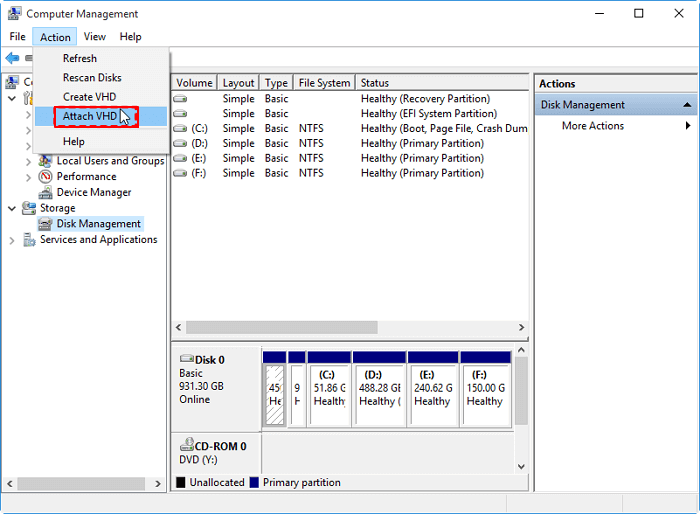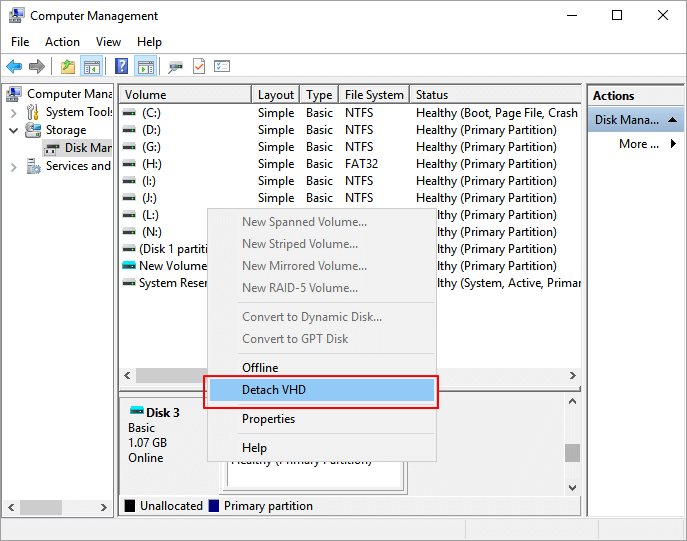Easy VHD to Physical Disk Solution
| Workable Solutions | Step-by-step Troubleshooting |
|---|---|
| Fix 1. Copy VHD to a Physical Disk | Step 1: Select the source disk. Right-click the disk that you want to copy or clone. Then, select "Clone"...Full steps |
| Fix 2. Convert a VHD to Physical Disk | Step 1: Open Disk Management, right-click on the VHD disk, and select "Detach VHD"...Full steps |
If you are looking for a way to restore VHD or VHDX to physical disk on Windows 10/8/7/XP, and even Windows server platforms, stay here. This page explains what is VHD and offers practical methods to help you convert a VHD to a physical disk without losing any data.

What Is a VHD
According to Wikipedia, VHD, short for Virtual Hard Disk, is a file format that represents a virtual hard disk drive (HDD).
A VHD is usually used to emulate an actual disk storage device. You can save what is found on a physical HDD, such as disk partitions and a file system, files, and folders, etc., on a virtual disk. A virtual disk is used as the hard disk on a virtual machine.

By using Disk Management, you can create as many virtual HDDs as you want on your computer. You can either save files, folders, etc. on the disk or you can also use the virtual disk to do some tests without hurting your real disks nor damaging your vital data.
Besides, it has many other advantages:
- IT organizations can deploy standardized, 'pre-built' configurations on a single VHD.
- Changes to the contents of a VHD are easily undone.
- Many current operating systems support having multiple users but offer varying degrees of protection between them.
Apart from these advantages, it still has limitations.
- The VHD has a maximum size limit: 2 TB for the size of any dynamic or differencing VHDs.
- It only allows a maximum of 65535×16×255 sectors.
Note that a virtual disk only works as a physical disk when the virtual machine is running. Once you shut down the virtual machine, you will no longer be able to access the VHD or the saved files on it.
Can I Copy VHD to Physical Disk
"I have a Lenovo laptop that runs Windows XP. At the same time, I set up Windows 7 on a VHD. Now I want to upgrade my computer from XP to Windows 7. But there is no straight upgrade path, and I have to copy VHD to a physical disk so as to move the content of the VHD to my real hard drive. But I don't know how to clone VHD to the physical disk? Do you have any suggestions?"
"Hi there, does anyone know how do I convert a VHD disk to a physical disk? Or how can I restore the VHD space to my local hard drive? I'm about to upgrade my computer to the latest Windows 10 and I don't want to keep the VHD disk anymore. So how do I recover my VHD files to a physical disk?"
According to many VHD users, it seems that people tend to convert or restore VHD to a physical disk when they don't need to use a virtual machine anymore. In the following, we've connected the easiest VHD to Disk conversion solution to help you effectively restore a VHD file and its space back to a physical disk.
Best VHD to Disk Conversion Solution
Have you ever wanted to copy a VHD to a physical disk, or copy a VHDX file to a physical disk?
Mostly, when people want to do a complete new setup of the computer or virtual machine, they would choose to copy a virtual hard disk to the physical hard drive. Manually copying is files from the virtual disk to a physical disk is easy but time-consuming.
Here, on the following, we would like to offer you an efficient VHD to disk method. You can do this by using a VHD to disk migration tool - Qiling partition software.
You can simply download Qiling partition software - Partition Master, create a disk clone task, choosing the virtual disk (VHD, VHDX, etc.) as a source disk and the physical disk as the target disk, and then execute the disk copy operation. In this way, it allows you to easily duplicate the contents of the virtual hard disk to the physical drive.
When the process gets done, you may then restore the VHD space back to the physical disk by simply deleting the VHD file on your local disk.
Tutorial: Steps to Copy the VHD to a Physical Disk
Follow the tutorial steps here to learn how to effectively migrate your VHD disk data to a local disk and restore the VHD space back to your computer.
#1. Copy VHD to a Physical Disk
Right-click My Computer > Manage > Storage > Disk Management, right-click Disk Management and choose Attach VHD.

To obtain a smooth the VHD to a physical disk cloning process, remember to select an empty local physical HDD as your target disk. If the target disk that you choose has partitions on it, the wizard will ask you to delete all the partitions on the disk. So back up your data in advance.
Follow the steps below to copy your virtual disk:
Step 1. Select the source disk.
Right-click the disk that you want to copy or clone. Then, select "Clone".
Step 2. Select the target disk.
Choose the wanted HDD/SSD as your destination and click "Next" to continue.
Step 3. View the disk layout and edit the target disk partition size.
Then click "Continue" when the program warns it will wipe out all data on the target disk. (If you have valuable data on the target disk, back up it in advance.)
You can select "Autofit the disk", "Clone as the source" or "Edit disk layout" to customize your disk layout. (Select the last one if you want to leave more space for C drive.)
Step 4. Click "Proceed" to start the disk cloning process.
If you need to re-partition the virtual disk after cloning, you can also apply Qiling Partition Master with its advanced features to re-manage the disk. You may refer to Partition Hard Drive as a guide.
#2. Convert a VHD to Physical Disk
After the cloning, you can now start to restore your VHD space to a physical disk with the following steps:
Step 1. Open Disk Management, right-click on the VHD disk, and select "Detach VHD".

Step 2. Open Windows File Explorer and locate your local VHD file on your computer.
Step 3. Find the VHD file - .vhd or .vhdx and right-click to delete it.
Step 4. Confirm the deletion.
After this, you've successfully returned the virtual disk space back to the local disk on your PC.
Extended Reading
On this page, we introduced an efficient way to help users copy VHD content to local HDD and restore the virtual disk space to a physic disk. Aside from this issue, some users also have more questions about VHD and virtual machines.
Here, we collected several questions and listed a brief answer to each question. If you have the same doubts, follow and check out the answers.
1. How to extend VHD disk size?
Mostly, once the VHD is created on the Windows computer, the size cannot be changed. If you need to extend the VHD disk size, you will need to delete the original .vhd file on your computer and then recreate a new VHD, setting a bigger size to it.
Remember to back up or clone the VHD disk data to your local disk first with the above-presented method.
Also, the ways to extend VHD disk size in Disk Management and virtual machine are different. Here is a brief guide:
To extend VHD disk space on local Windows PC:
- First. Enter Disk Management, right-click to detach the VHD disk.
- Next. Locate and delete the .vhd or .vhdx file on your computer.
- Then. Re-enter Disk Management, and select "Create VHD" under the Action section, setting a bigger size for your new virtual disk.
To extend the disk space in Virtual Machine:
- First. Open the virtual machine console, such as VMware Workstation > Click the OS and enter virtual machine settings.
- Next. Select the Hard Disk > Click Expand > Set a new maximum size for your virtual disk.
2. How to recover VHD files?
When you mistakenly deleted or removed files on a virtual machine, you can first try to find them from the Recycle Bin. If nothing appears, you can then try to install a file recovery software like Deep Data Recovery to scan and restore lost VHD files.
3. What's the difference between VHD and VHDX?
The biggest difference between VHD and VHDX is their storage capacity. A traditional VHD disk has a 2TB maximum capacity limit while the VHDX breaks the limit.
A VHDX supports to store up to 64TB in size. A VHDX format also works to prevent file corruption due to power failure.
4. What is Disk2vhd?
Disk2vhd is a tool that creates virtual hard disk on physical disks for use in Microsoft Virtual PC or Microsoft Hyper-v virtual machines. Disk2vhd can run on a system that is online. Users can even create VHDs on local disk, preserving partitioning information of the disk and enabling users to capture just system volumes and exclude data volumes.
Wrapping Up
This page covers a basic introduction of VHD and offers a straight forward way to help you convert VHD to physical HDD without losing any data. If you happen to have the same request, apply Qiling Partition Master to copy your VHD content first and then delete the VHD file from the local disk.
You can also uninstall the virtual machine utility from your PC to free up more space for your PC.
Related Articles
- How to Convert GPT to MBR (Without Data Loss) with 3 GPT to MBR Converter
- How to Fix USB won't format to FAT32, Check Three Easy Ways
- Windows 11 Download Without TPM 2.0 [Windows 11 Installation Guide]
- Windows 11 Is Not Booting? Your Fixes Are Here!